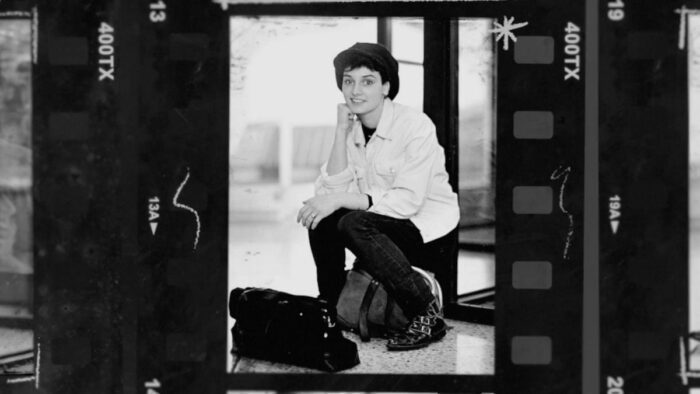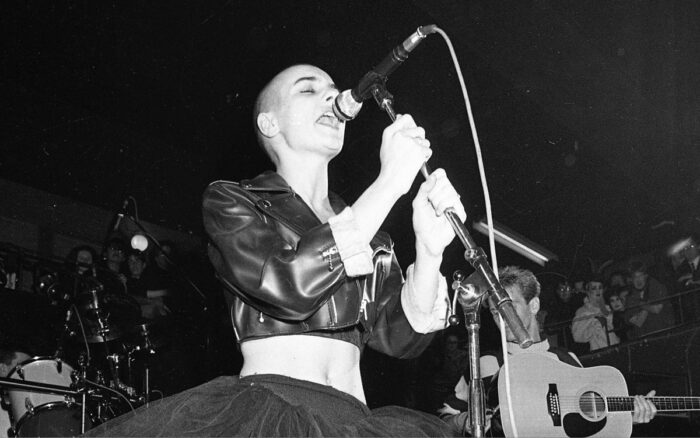One thing I love to see about the current pop-music/pop-culture landscape: that young female and LGBTQ+ artists can and often do speak their minds, freely and without fear of consequence, on the issues that matter to them most, both in their music and on social media. And especially on matters of body autonomy. There’s a sequence near the end of Nothing Compares, a new documentary directed by Kathryn Ferguson for Showtime on the life and art of Sinéad O’Connor, where some of the new guard—M.I.A., Ariana Grande, Megan Thee Stallion, Billie Eilish—defend the rights of women. “Shut the f*ck up about our bodies!” Eilish exclaims in a fury. However encouraging it may be to see women take the stage and voice their opinions, Nothing Compares reminds us all there was a time not long ago when the price for a woman to protest was steep, indeed.
For a time in the late 1980s and early 1990s, Sinéad O’Connor’s music was ubiquitous on the airwaves (pre-Internet, we listened to music on the radio, cassette tapes, and what was then the cutting edge, the newfangled compact disc) and MTV, back when it played music videos nonstop. She’d quickly transcended the punk-folk scene in England to international fame, especially with her breakout second album, I Do Not Want What I Haven’t Got and its #1 world single of 1990, the Prince-penned “Nothing Compares 2 U.” That record, and the signature music video for “Nothing Compares” with the black-turtlenecked singer staring down the camera in unflinching close-up, marked the apex of her musical fame, though those who knew only the hit single were missing a wealth of smart deep cuts from I Do Not Want (the Colin Roach-inspired “Black Boys on Mopeds,” the stately “The Last Day of Our Acquaintance,” the punky “Jump in the River”) and its predecessor The Lion and the Cobra with “Mandinka” and “I Want Your (Hands on Me).”

In short, O’Connor was no one-hit wonder but a compelling singer-songwriter with a uniquely androgynous look, her signature shaved or closely-shorn locks, boyish or formless wardrobe, and hugely expressive eyes commanding attention for her refusal to conform to established gender norms. Her huge voice, an impressive instrument commanded from a tiny body, wrangled Irish folk and soul influences through Van Morrison into punk wails, rock shrieks, and pop melodies with equal grace. Ironically, though she was known best for a song composed by Prince, she was also an excellent songwriter, capable of an intensely personal directness that did not lack in the least for uniquely melodic expression. In contrast to the biggest star of her era, unlike Madonna, O’Connor did not trade blithely on her own sexuality (though it was nonetheless smoldering) and bravely defied institutional authority.
Her doing so came to a head on an October 1992 episode of Saturday Night Live. O’Connor didn’t perform her biggest hit but instead covered Bob Marley’s “War,” a song with lyrics adapted from Haile Selassie’s stirring 1963 speech to the United Nations General Assembly, edited for this performance to address child abuse. As she hit the final notes, she held a photo of then-Pope John Paul II, the representative of what she saw as her lifelong arch-nemesis the Catholic Church, and in front of a live television audience ripped it to shreds with the words “fight the real enemy.”
Would it matter that a decade later, she was proved right, when the abuse she addressed onstage came to light in a Boston Globe report leading the arrest of five Catholic priests accused of sexual abuse?
No, not for some time, as O’Connor’s unscripted, unrehearsed act was met with disdain—from SNL producer Lorne Michaels, assorted cast members, Madonna (who was herself perfectly content with exploiting Catholicism for profit), the Church, and the media and the public at large. The episode became a worldwide furor eclipsing her artistry, and O’Connor’s steadfast refusal to apologize led to her exile from the mainstream of pop culture. She would continue to record and tour, but audiences and critics were newly hostile to a star they had previously adored.
Ferguson’s documentary charts both OʼConnorʼs phenomenal rise to worldwide fame and her quick fall from it, beginning with a chorus of boos at a post-SNL appearance and later returning to the same scene with a fuller, deeper context that explains just how fully audiences had turned on her—and she on them. Much of the documentary’s first act explores O’Connor’s Irish childhood with catholic imagery, subtle reenactments, and archival photos. Her pedestrian upbringing cloaked a massive talent, but hers was a voice that simply couldn’t be kept quiet.

With a number of interviews from O’Connor’s friends and collaborators, Ferguson nimbly leaps through the singer’s adolescence and maturation playing clubs in London before her breakout solo work. But Nothing Compares is not only about O’Connor’s indelible musicianship: it’s equally about her personal politics, formed in rebellion against the Catholicism forced on her at an early age. And that’s a position Ferguson makes perfectly clear, that for a singer like O’Connor, the personal is the political, and vice versa: long before intersectionality and transgenderism became part of a global lexicon, there was this slight, shorn, androgynous, appealing, evocative singer subverting pop conventions with feminist performance art aimed at, and reaching, wide audiences.

Speaking of which, the singular performance for which O’Connor is best known (aside from the SNL debacle), and the song lending its title to the documentary, “Nothing Compares 2 U,” is oddly absent here. The Prince estate did not lend its permission to the song’s use, and consequently, only some brief images and outtakes from the video shoot—itself iconic—are presented. You might find yourself wondering why long before a title card announcing that fact is presented at the film’s end. But here it is, after thirty-plus years, in all its evocative, teary-eyed glory.
Earlier this year, O’Connor announced, then retracted, her retirement. One might wonder of Ferguson’s documentary, why now? (O’Connor, who is now known as Shuhada Sadaqat, is still active, at 55, if less prolific a performer than in her heyday, and apparently planning a new career as a writer.) So often rock-docs appear long after an artist is gone (looking at you, Get Back and Moonage Daydream) or when no longer performing (say, Linda Ronstadt: The Sound of My Voice). But Nothing Compares is nothing less than absolutely timely at a moment when legislatures, politicians, and courts have launched a new and unprecedented attack on reproductive rights and bodily autonomy. That we have today musical artists who can and do speak out without fear of censorship, reprisal, or exile is thanks in no small part to an artist like O’Connor, whose own outspokenness, necessary and correct as it was, was met with a rebuke far in excess of any it might have merited.
Nothing Compares does not aim for a cinematically expressive or unusual presentation of O’Connor’s art: it’s a traditionally expository documentary, straightforward in its approach, using voice-over interviews (of uneven audio quality) mixed over archival footage and occasional reenactment in a careful chronology. But that’s no criticism: in focusing primarily on the singer’s fame from 1987-1993, Nothing Compares presents a rich, uncompromising portrait of an equally uncompromising artist whose words and work won her a world of fans before she became an object of an absurdly undeserved scorn.
Nothing Compares is available to stream for SHOWTIME subscribers Friday, September 30 ahead of its on-air premiere Sunday, October 2 at 10 p.m. ET/PT.



